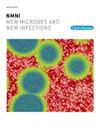黎巴嫩革兰氏阳性病原体的流行和抗微生物药物耐药性:监测和管理的必要性
IF 5.4
Q2 INFECTIOUS DISEASES
引用次数: 0
摘要
背景耐甲氧西林金黄色葡萄球菌(MRSA)和耐万古霉素肠球菌(VRE)等革兰氏阳性菌的耐药性在全球范围内构成了重大的医疗挑战。然而,黎巴嫩有关这些微生物的数据仍然有限。这项回顾性研究旨在评估 2017 年至 2023 年黎巴嫩 Geitaoui - UMC 医院临床感染中金黄色葡萄球菌(S. aureus)、凝固酶阴性葡萄球菌(CoNS)和肠球菌属的流行率和抗菌药耐药性模式。方法从尿液、血液、呼吸道标本和其他感染部位共收集了 2676 份分离物。细菌鉴定按照世界卫生组织临床细菌学程序进行,采用革兰氏染色法、过氧化氢酶和凝固酶检测法以及生化检测法。抗菌药敏感性测试采用柯比-鲍尔盘扩散法和最小抑菌浓度(MIC)分析法进行,根据临床和实验室标准协会(CLSI)指南进行解释。统计分析采用 SPSS® 24 版进行,显著性以 p < 0.05 为标准。结果柯萨奇菌最常见(42.83%),其次是肠球菌属(28.81%)和金黄色葡萄球菌(28.36%)。血液培养的分离率最高(29.04%),主要是 CoNS(76.45%)。肠球菌属在尿路感染中占主导地位(85.01%),而金黄色葡萄球菌在伤口/手术部位感染中占多数(59.23%)。性别特异性趋势显示,男性更易感染 CoNS 和金黄色葡萄球菌,而女性更易感染肠球菌属。研究结果凸显了持续监测和严格的抗生素管理以有效对抗抗菌药耐药性的必要性。本文章由计算机程序翻译,如有差异,请以英文原文为准。

Prevalence and antimicrobial resistance of gram-positive pathogens in Lebanon: The need for surveillance and stewardship
Background
Resistance in Gram-positive organisms, including methicillin-resistant Staphylococcus aureus (MRSA) and vancomycin-resistant Enterococcus (VRE), poses a significant healthcare challenge globally. However, data on these organisms in Lebanon remain limited. This retrospective study aimed to assess the prevalence and antimicrobial resistance patterns of Staphylococcus aureus (S. aureus), coagulase-negative Staphylococci (CoNS), and Enterococcus spp. in clinical infections at the Lebanese Hospital Geitaoui – UMC from 2017 to 2023.
Methods
A total of 2676 isolates were collected from urine, blood, respiratory specimens, and other infection sites. Bacterial identification was performed following WHO clinical bacteriology procedures, utilizing gram staining, catalase and coagulase tests, and biochemical assays. Antimicrobial susceptibility testing was conducted using the Kirby-Bauer disk diffusion method and minimum inhibitory concentration (MIC) analysis, interpreted according to Clinical and Laboratory Standards Institute (CLSI) guidelines. Statistical analyses were performed using SPSS® version 24, with significance set at p < 0.05.
Results
CoNS were the most prevalent (42.83 %), followed by Enterococcus spp. (28.81 %) and S. aureus (28.36 %). Blood cultures had the highest isolation rates (29.04 %), predominantly CoNS (76.45 %). Enterococcus spp. dominated urinary tract infections (85.01 %), while S. aureus was prevalent in wound/surgical site infections (59.23 %). Gender-specific trends showed CoNS and S. aureus more in males, while Enterococcus spp. infections were more common in females.
Conclusion
This study provides valuable insights into the prevalence and resistance patterns of Gram-positive pathogens in a Lebanese hospital setting. The findings highlight the need for continuous surveillance and stringent antibiotic stewardship to combat antimicrobial resistance effectively.
求助全文
通过发布文献求助,成功后即可免费获取论文全文。
去求助
来源期刊

New Microbes and New Infections
Medicine-Infectious Diseases
CiteScore
10.00
自引率
2.50%
发文量
91
审稿时长
114 days
 求助内容:
求助内容: 应助结果提醒方式:
应助结果提醒方式:


